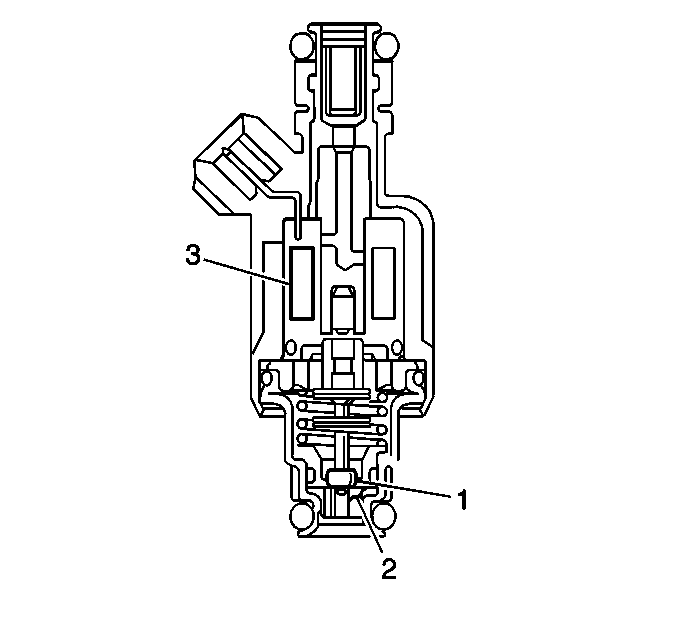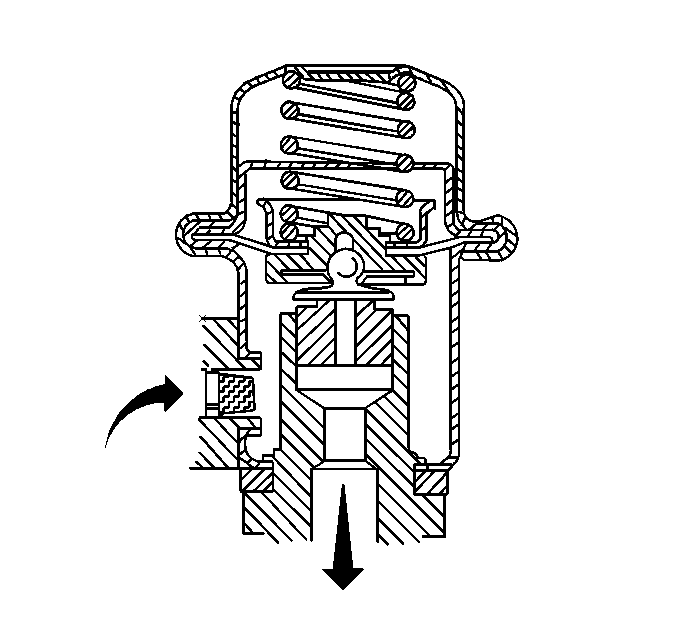The fuel metering system is made up of the following parts:
| • | Fuel supply components (fuel tank, pump, and lines). |
| • | Fuel pump electrical circuit. |
| • | Fuel rail assembly, including: |
| - | Fuel pressure regulator. |
| • | Throttle body assembly, including: |
| - | Idle Air Control (IAC) valve. |
| - | Throttle Position (TP) sensor. |
Fuel Pump Electrical Circuit
When the ignition switch is turned to the ON position, the PCM energizes
the fuel pump relay for 2 seconds allowing the fuel pump to pressurize the
fuel system. If the PCM does not receive any ignition reference pulses (engine
cranking or running) within 2 seconds, the PCM de-energizes the fuel
pump relay; this causes the fuel pump to stop.
An inoperative fuel pump relay can result in long cranking times.
Accelerator Controls
The accelerator control system is a cable type and there are no linkage
adjustments. Therefore, the only specific cable for each application must
be used. When work has been performed on the accelerator controls, always
make sure that all components are installed correctly and that the linkage
and cables are not rubbing or binding in any manner. The throttle should
operate freely without binding between full closed and wide open throttle.
Fuel Injectors

The fuel injector assembly
is a solenoid-operated device, controlled by the PCM, that meters pressurized
fuel to a single engine cylinder. The PCM energizes the fuel injector solenoid
(3), which opens a ball valve (1), allowing fuel to flow past the ball valve,
and through a recessed flow director plate (2) at the injector outlet. The
director plate has machined holes that control the fuel flow, generating
a conical spray pattern of finely atomized fuel at the injector tip. Fuel
from the tip is directed at the intake valve, causing it to become further
atomized and vaporized before entering the combustion chamber. A fuel injector
that is stuck partly open would cause loss of pressure after the engine
is shut down, so long crank times would be noticed on some engines. Dieseling
could also occur because some fuel could be delivered to the engine after
the ignition is turned OFF.
Fuel Pressure Regulator Assembly

The fuel pressure regulator
assembly is a diaphragm-operated relief valve with fuel pump pressure on
one side, and a regulator spring pressure and intake manifold vacuum on the
other side. The regulator's function is to maintain a constant pressure differential
across the injectors at all times. The pressure regulator compensates for
engine load by increasing the fuel pressure as the engine vacuum drops. The
fuel pressure regulator is serviced as a complete assembly. With the ignition
ON and engine OFF (zero vacuum), fuel pressure should be 284-325 kPa
(41-47 psi). Whenever the pressure is too low, poor performance and
a DTC P0171 could result. Whenever the pressure is too high, excessive odor
and a DTC P0172 could result.
Throttle Position (TP) Sensor
The nonadjustable, throttle shaft-driven TP sensor is mounted on the
throttle body assembly opposite the throttle cam lever. The TP sensor
senses the throttle valve angle and relays the information to the Powertrain
Control Module (PCM). Knowledge of throttle angle is needed by the
PCM to properly control the injector control signals (pulses).
Idle Air Control (IAC) Valve Assembly

Engine idle speed is controlled by the PCM through the IAC valve (1)
mounted on the throttle body. The PCM sends voltage pulses to the IAC valve
motor windings causing the IAC valve pintle (3) to move IN (toward the seat)
or OUT (away from the seat) a given distance (a step or count) for each pulse.
The commanded location (steps away from the seated position) can be observed
as a number of counts displayed on a scan tool. The pintle movement controls
the airflow around the throttle valve (2), which in turn, controls engine
idle speed: Pintle Extended=Decrease RPM=Lower Counts. Pintle Retracted=Increase
RPM=Higher Counts.
| • | The controlled or desired idle speed for all engine operating
conditions is programmed into the EEPROM of the PCM. The programmed engine
speeds are based on coolant temperature, park/neutral switch status, vehicle
speed, battery voltage, and A/C refrigerant pressure (if equipped). |
| • | The PCM learns the proper IAC valve positions to achieve warm,
stabilized idle speeds (RPM), desired for the various conditions (P/N or Drive,
A/C ON or OFF, if equipped). This information is stored in PCM Keep Alive
memories (information is retained after ignition is OFF). All other IAC valve
positioning is calculated based on these memory values. As a result, engine
variations due to wear, and variations in minimum throttle valve position
(within limits) do not affect engine idle speeds. This system provides correct
idle control under all conditions. This also means that disconnecting power
to the PCM can result in incorrect idle control or the necessity to partially
depress the accelerator when starting, until the PCM relearns idle control. |
| • | Engine idle speed is a function of total airflow into the engine
based on IAC valve pintle position plus throttle valve opening plus calibrated
vacuum loss through accessories. |
| • | The minimum throttle valve position is set at the factory with
a stop screw. This setting allows enough air flow by the closed throttle valve
to cause the IAC valve pintle to be positioned a calibrated number of steps
(counts) from the seat during controlled idle operation. The minimum throttle
valve position for this engine is not the same as the minimum idle speed
associated with other fuel injected engines. The throttle stop screw is filled
at the factory following an adjustment. |
| | Important: Do Not try to remove the filler and readjust the stop screw. Misadjustment
may set a DTC P0506 or a DTC P0507.
|
| • | The PCM normally resets the IAC valve pintle position once during
each ignition cycle when vehicle speed increases above 20 mph on moderate
acceleration. During the reset, the PCM commands the IAC valve pintle to
retract completely, then move IN to the seated position (to establish the
zero count position), and then back out to the desired position. The IAC
is relearned only once per ignition cycle. |
| • | The IAC valve also can be reset without driving the vehicle by
using this service procedure: |
| 1. | Turn ignition switch to the ON position (engine OFF). |
| 2. | Turn ignition OFF for ten seconds. |
| 3. | Start engine and check for proper idle operation. |
| • | Whenever the IAC valve is disconnected and reconnected while the
engine is running, the resulting IAC valve counts may not correspond with
the actual IAC valve pintle position. When servicing the IAC valve, it should
only be disconnected or connected after the ignition has been OFF for at
least 10 seconds. This allows time for the PCM to move the IAC valve to the
150 count position where it is parked while the ignition is OFF. Whenever
this procedure is not followed, the PCM will lose track of IAC valve position
resulting in starting or idle control problems until the IAC valve is reset
and pintle position is relearned. |
| • | IAC system problems may cause improper idle speeds, resulting
in a DTC P0506 or a DTC P0507. The DTC P0506 or the DTC P0507 tables should
be used to diagnose these problems. |



